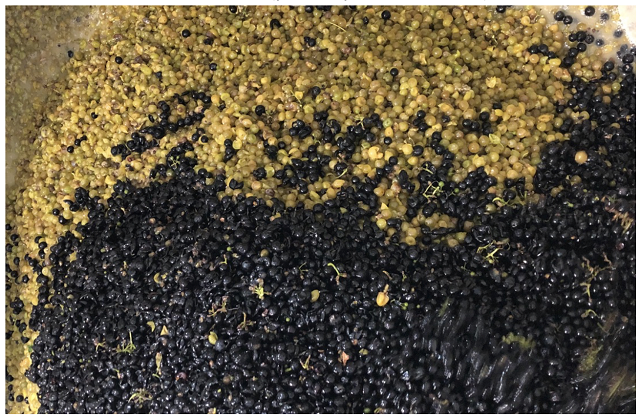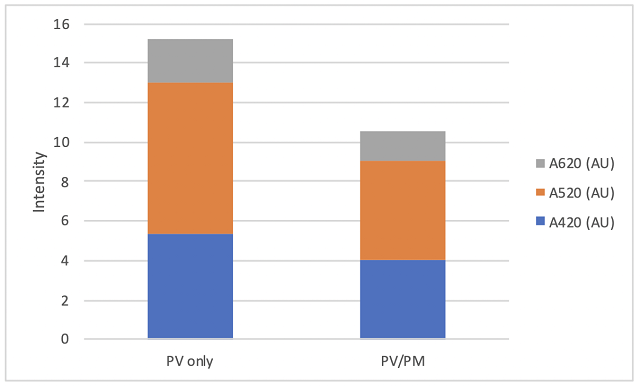Co-fermentation of Petit Verdot with Petit Manseng
Matthieu Finot
King Family Vineyards
Summary
The purpose of this experiment was to explore the chemical and sensory effects of co-fermenting Petit Verdot with Petit Manseng. Chemical and sensory characteristics of a co-fermentation using 75% Petit Verdot/25% Petit Manseng were compared to those from a fermentation of 100% Petit Verdot. The co-fermented wine had higher alcohol (despite very similar starting Brix), higher potassium, slightly higher pH, and notably lower color intensity. Anthocyanin concentrations were also lower in the co-fermented wine. Other phenolic measurements were largely the same, with the co-fermented wine having only 7% lower tannin than the control wine. In a blind tasting by four winemakers, the Petit Verdot was described as a dark, concentrated, structured wine with very positive and classic descriptors for varietal character. The co-fermented wine was noted as very different from the Petit Verdot with descriptors including tropical, citrus, floral aromas and noticeably lighter color. The mouthfeel was described as “bright”, “rounder but with length and sweetness”, but also “grippy”, with “more tannin perception”.
Introduction
The purpose of this experiment was to explore the chemical and sensory effects of co-fermenting Petit Verdot with Petit Manseng. Co-fermentation is “the simultaneous fermentation of two or more varieties in the same vessel”1. This ancient technique likely arose from a time when vineyards were interplanted with several varieties, either due to the availability of replacement vines or simply the lack of techniques to determine varietal identity. Some well-known wines have traditionally been produced as co-ferments including Côte Rôtie from the Northern Rhône which usually includes 5-10% Viognier added to Syrah. Chianti Classico was historically a co-ferment of Sangiovese with the indigenous red grape Canaiolo Nero as well Trebbiano and Malvasia, both white varieties. Interplanted vineyards can also be found in the New World. Bucklin’s Old Hill Ranch vineyard, one of the oldest in California, is an interplanting of 16 varieties on 12 acres, all harvested and vinified together2. Ridge Vineyards Geyserville “Old Patch” contains vines up to 130 years old that include Zinfandel interplanted with Carignane, Petit Syrah and Mourvedre. This vineyard is picked and vinified as a co-fermented field blend with stunning results.
Winemakers use co-fermentation for many reasons. Some cite a “lifting of the aromas”, “enhanced texture”, “softening of the wine” or “improved brilliance and intensity of color”1,3, while others, like Bucklin and Ridge, honor their terroir and history. Co-fermenting Petit Verdot and Petit Manseng stems from several factors:
- Petit Verdot is a dark fruited red variety with poor acidity, likely due to high potassium load in the skins.
- Petit Manseng is a high acid, high Brix white variety that is ripe around the same time as Petit Verdot.
- The Petit Verdot block of the Crown Orchard in Batesville, Virginia contains four short rows of Petit Manseng. Though this was not the Petit Manseng used in this trial, it presents a possible co-harvest in the future.
In this trial, the chemical, phenolic and sensory characteristics of a co-fermentation using 75% Petit Verdot/25% Petit Manseng are compared to those from a fermentation of 100% Petit Verdot.
Methods
Petit Manseng and Petit Verdot grapes were hand harvested on the same day (9/23) and chilled overnight. Grapes were destemmed to 1.5 ton Bins the following day with the addition of 15ppm SO2. Grapes were loaded into bins according to weight, with the treatment bin receiving 75% Petit Verdot and 25% Petit Manseng by weight (Figure 1). The control bin received 100% Petit Verdot. The following day (9/26), bins were inoculated with 12 g/hL D254 yeast (Scottlabs). Fermentations were punched down twice per day and monitored daily for Brix and temperature. Tartaric acid (1 g/L) was added after fermentation, before pressing (on 10/10). Both bins were pressed the same day (10/11) after 7 days of extended maceration. Wine was allowed to settle for 1-2 days prior to racking and transfer to identical barrels. Malolactic conversion occurred naturally in barrel. At the completion of malolactic fermentation, 3 g/hL Stab Micro (Enartis), 2 g/L tartaric acid, and 66ppm SO2 were added to each barrel. Due to restrictions put in place during the COVID-19 pandemic, group sensory analysis was not done on these wines. However, four winemakers tasted the wines blind and wrote open ended notes, followed by a panel discussion of the wines. The full recording of this panel discussion can be found on the WRE YouTube channel.
Results
Initial juice chemistry shows very similar sugar levels with slightly lower pH for the co-ferment (Table 1). The control wine fermented faster and finished earlier than the co-fermented wine. The cap on the control wine had dropped by the time both bins were pressed while the co-fermented wine still had an intact cap when pressed (Matthieu Finot, personal communication).
Figure 1: Petit Verdot and Petit Manseng grapes were destemmed into the same TBin for co-fermentation (photo by Matthieu Finot)

Table 1: Red fruit chemistry after crush for two treatments of Petit Verdot (in-house lab)

The co-fermented wine had higher alcohol, consistent with slower (cooler) fermentation, as well as higher potassium and slightly higher pH (Table 2). Though Petit Verdot is thought to contain high levels of potassium that contribute to its high pH, Petit Manseng may also have high potassium. Petit Manseng has very small berries, leading to a high skin:pulp ratio. The drop in acidity often attributed to high potassium is not seen as often in Petit Manseng white wines due to limited if any skin contact in wines made from this variety. However, in a WRE experiment testing skin fermentation of Petit Manseng in 2018, Emily Pelton found finished Petit Manseng wine with pH values of 4.1 and 4.2. Addition of Petit Manseng to red wine fermentations, therefore, may not help acidity but rather have a detrimental effect on this parameter.
Table 2: General wine chemistry for two treatments of Petit Verdot (ICV labs)

The co-fermented wine also had notably lower color intensity (Figure 2), with a hue of 0.80 compared to a hue of 0.70 in the control wine. Higher hue indicates a shift toward the yellow portion of the spectrum, away from the red. The difference in color intensity is likely due to dilution of anthocyanins, as seen in values for all categories of anthocyanins measured (Table 3). Though anthocyanins showed large differences, other phenolic measurements were largely the same (Table 4), with the co-fermented wine having only 7% lower tannin than the control wine.
In a blind tasting by four winemakers, the Petit Verdot was described as a dark, concentrated, structured wine with very positive and classic descriptors for varietal character. The co-fermented wine was noted as very different. Descriptors include tropical, citrus, floral aromas and noticeably lighter color. The mouthfeel was described as “bright”, “rounder but with length and sweetness”, but also “grippy”, with “more tannin perception”. This was a higher alcohol wine, and one winemaker remarked the alcohol was more apparent in the co-ferment.
Figure 2: Color intensity for two treatments of Petit Verdot (ICV labs)

Table 3: Anthocyanins for two treatments of Petit Verdot (mg/L) (ETS Labs)

Table 4: Phenolics for two treatments of Petit Verdot (mg/L) (ETS Labs)

References
(1) Robinson, J. The Oxford Companion to Wine, Third Edition.; Oxford University Press: Oxford, 2006.
(2) Bucklin, W. Vineyard Map. Bucklin Old Hill Ranch.
(3) Jackson, R. S. Wine Science: Principles and Applications, 4th Edition.; Academic Press: Amsterdam, 2014.
